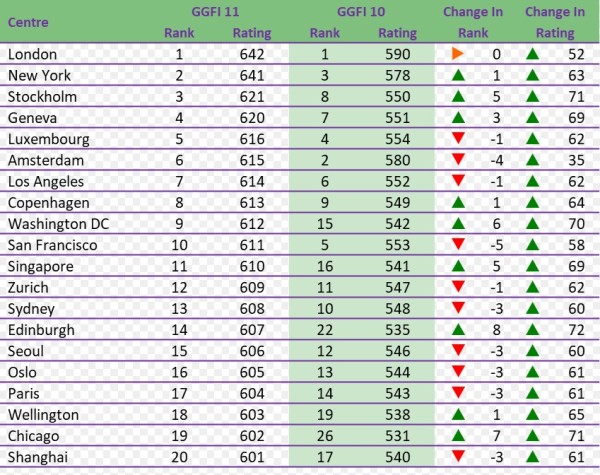Z/Yen Group: Global Green Finance Index 11

The 11th edition of the Global Green Finance Index (GGFI) evaluates green finance offerings from 86 financial centres. The GGFI serves as a valuable measure of the development of green finance for policy and investment decision-makers and is sponsored by Abu Dhabi Global Market (ADGM).
The top 20 centres in GGFI 11 are shown in the table below.

GGFI 11 Headlines
- Western European centres take six of the top 10 places, with US centres taking the other four top 10 places.
- London retained its first position in the index, with New York moving up one place to take second place.
- Washington moved into the top 10, replacing Sydney.
- The margins separating centres at the top of the index continue to be tight. Among the top 10 centres the spread of ratings is 31 out of 1,000, compared to 42 out of 1,000 in GGFI 10.
- Confidence in green finance as a sector is strong. All centres improved their rating in GGFCI 11. The average rating rose over 10% compared with GGFI 10. Much of this confidence may be due to significant US commitments to prevent climate change and promote green infrastructure, in particular the US$391 billion Inflation Reduction Act and the US$108 billion Bipartisan Infrastructure Law.
In the supplement to this edition of the GGFI, we focus on transition finance, and the efforts to move away from fossil fuels to renewable energy sources. The exposure of companies, economies and financial centres to transition risk needs both further research and policy change.
We researched 126 financial centres for GGFI 11. The number of centres in the index has increased to 86, with the addition of Lagos and Kigali.
Professor Michael Mainelli, Chairman of Z/Yen Group, said:
'While Western European and US centres take all top 10 positions in the index, don’t ignore how recently US centres got with the programme, and how rapidly Asian centres are moving up. At COP3 in Kyoto in 1997, carbon markets were the preferred anti-climate change mechanism. It may have been a slow quarter century burn, but three-quarters of those responding to GGFI 11 expect 30% or more of greenhouse gas emissions to be covered by carbon pricing by 2030, up from 21% at the end of 2021 and 15% in 2020.'










